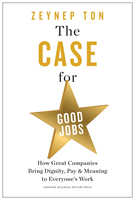The Case for Good Jobs
June 01, 2023
Good jobs can be hard to find. But, as I learned early in life, they can also be found in the most unexpected of places. MIT Sloan professor Zeynep Ton has a new book explaining how they're created.
 The Case for Good Jobs: How Great Companies Bring Dignity, Pay, and Meaning to Everyone's Work by Zeynep Ton, Harvard Business Review Press
The Case for Good Jobs: How Great Companies Bring Dignity, Pay, and Meaning to Everyone's Work by Zeynep Ton, Harvard Business Review Press
What defines a good job?
There is no one factor, on its own, but rather multiple elements working in tandem and intentionally fostered by company leaders. In her new book, The Case for Good Jobs, MIT Sloan professor Zeynep Ton calls this the “good jobs system.” It may seem hard to attain, but it can exist anywhere that people are at the heart of every decision. I know this from experience.
You see, my very first job at the age of sixteen was a frontline job: I was a drive-thru cashier at my local Taco Bell. I thought it would be a straightforward, even boring way to earn some spending money after school—all I had to do was take cash, hand over tacos, rinse and repeat, right?
Not so. Our franchise owners believed creating a great customer experience was the top priority, from which profits would naturally flow. This translated into one of the most thorough job training regimens I’ve ever undergone. I spent my first weeks on the job watching training videos and memorizing ingredient lists for every item on our menu, which my shift managers then quizzed me on. Then, even though I was only meant to work at the cash register, I moved into the kitchen to cross-train under the veteran employees who taught me how to measure exact ingredient portions by sight and to flawlessly roll and wrap up a burrito—a skill I am, to this day, still very proud of. Our cross-training meant we could perform our assigned roles but also help each other out seamlessly. By the time I got scheduled for my first shift on the drive-thru register, I felt like an expert because I had, in fact, been trained to be one.
Being good at my job helped everyone else on the team focus on being good at theirs—I didn’t need to flag down a manager to balance my cash drawer mid-shift or slow down the kitchen crew with menu questions because I could do it all on my own. When the dinner rush picked up, we all seemed to move in a perfectly synchronized flow. As the motions of operating my register became muscle memory, I could direct my energy towards getting to know my regular customers, memorizing all the idiosyncrasies of their orders and remembering the little details of their lives that they shared during our brief conversations. I wouldn’t admit it back then—I was a teenager, after all—but I genuinely loved my job and the community that flourished around it.
Creating a great customer experience felt effortless because there was a structure in place for employees to facilitate it. The investment from management in my job training meant I could use my skills to brighten a customer’s day, whose repeated visits in turn built up a robust bottom line for the franchise, and so on.
These are all elements of Ton's good jobs system.
Companies that operate under the good jobs system, Ton argues, are successfully implementing five key elements in tandem. The first element is based on a company’s investment in its people:
[The] mental model at companies with a good jobs system is customer centric and therefore recognizes that frontline employees—the ones face-to-face with the customers—are the ones driving differentiation, growth, and profitability […] So those companies invest what it takes to attract the right people, train them, retain them, and keep expectations high. That investment includes higher wages, more stable schedules, promotion from within, and strong hiring, training, and performance management.
Once a company’s workforce is properly invested in, leaders must make the right operational choices. Making these choices requires an ongoing commitment—as I know from experience, any good job can easily regress into a bad one due to poor decision-making. Ton identifies these operational choices as: focus and simplify, standardize and empower, cross-train, and operate with slack.
To focus and simplify means zeroing in on the products and services that offer the most value to the customers and eliminating low-value offerings that are misaligned with the company’s mission and values. To standardize and empower involves taking input from frontline workers to understand what processes work (or don’t) and allowing them the autonomy to adjust according to customers’ needs. Cross-training gives employees the ability to adjust their work and assist their coworkers as needed. Finally, operating with slack involves having enough employees on hand to match the workload so that workers can avoid burnout and have the flexibility to respond to customer needs.
This is, of course, far from the norm. Otherwise, The Case for Good Jobs would not need to be written. They’d just exist. Currently, our society seems to be at an impasse—workers want good jobs, consumers want enjoyable experiences when interacting with a company, and company leaders want to be known for providing both. And yet, for decades now, largely ushered in by the ascent of Jack Welch as CEO of General Electric, success has been measured not by personal satisfaction and brand loyalty, but by hard numbers. We’ve lauded the business leaders who work to maximize their companies’ growth while slashing costs and shrinking their workforce. Home Depot, headed in the early 2000s by Welch protégé Bob Nardelli, saw an initial spike in profitability but a longer-term plummet in customer satisfaction scores after its workforce was heavily reduced. Today, companies like Amazon continue to boast billions of dollars in revenue even as their employees toil under unsafe conditions and customer satisfaction drops.
This type of numbers-oriented management creates unsustainable conditions for employees and customers alike. The law of conservation of energy posits that energy cannot be created or destroyed, but instead transfers or transforms; likewise, one could argue that costs cannot ever truly be slashed, but instead shift from direct to indirect costs. Ton notes that when companies reduce their investment in their workforce, the results are lost sales, lower productivity, and higher costs arising from workplace errors. This becomes a vicious cycle: low people investment begets high turnover, which begets poor operational execution, which begets low sales and profits, and on and on. And, Ton adds, “even a well-paid, well-trained workforce will be defeated by the wrong operational choices."
Two years into my time at Taco Bell, the good jobs system we had been operating under began to fall apart under the direction of a new district supervisor. What his motivations were—to prove his worth to the franchise owners, to fashion himself a mini-Jack Welch, whatever else—I'll never truly know. One day, I arrived for my shift as usual and found that only half of the usual number of crew members were scheduled for the day. When the dinner rush picked up, we were in a constant mad dash to try and keep up the pace, making clumsy mistakes along the way. A few weeks later, I was handed a standardized drive-thru script that had me awkwardly attempting to promote new menu items and upsell to customers whose orders I knew full well had never once changed in the years I’d known them. One of my regulars actually laughed and asked if I’d been replaced by a robot—I sounded nothing like myself.
But the worst was when the district supervisor started poring over our drive-thru window times, which were measured by pressure pads that detected how long a customer’s car idled at the window. He’d noticed some longer idle times in our daily records and determined that we must be serving customers too slowly and therefore creating an unpleasant experience.
The opposite, in fact, was true. Our drive-thru times looked long because our regulars often wanted to stop and chat, and we’d happily engage. We’d never received any negative feedback about it—if anything, we’d heard many times from customers who chose to drive out of their way to come to our location rather than one closer to home because of the level of care and attention we gave them. The idea that customers wanted faster service from us simply didn’t match the reality we were experiencing at the frontlines. But in the end, it became a pure numbers game. Neither our expertise, nor the reassurances from our customers that everything was fine as it was, could sway him away from this new goal.
We had to get customers through a transaction in something unfathomable like twenty seconds or less, no exceptions. Morale dropped. We made even more mistakes and even injured ourselves in our attempts to keep up. I had to shoo customers away so that our window times would stay low. Before long, our regulars stopped coming, sales started to drop, and managers who had been there for years quit. I had planned to stick with my job through college, but eventually I left, too.
But, just as a company operating under a bad jobs system can find itself trapped in a vicious cycle, companies operating under a good jobs system can enter a virtuous cycle:
Psychologist Robert Cialdini describes reciprocation as a widespread and basic norm of human culture and a powerful principle of persuasion. […] In successful adoptions of the good jobs system, this norm is in action. You give by investing in pay and making the employees’ job better, then you receive their commitment and hard work. […] You could say the secret of the good jobs system is all right there: most people want to do a good job and will appreciate whoever gives them the chance to do so.
Throughout the book, Ton presents comprehensive research demonstrating the tangible effects of good and bad job systems on employees, customers, and companies. She also highlights real-world success stories from companies that have long operated under a good jobs system, such as Trader Joe’s and Costco, and those that have seen major improvements after its adoption such as Quest Diagnostics, where employee turnover dropped by over 50% in eighteen months, and PayPal, where turnover dropped by 62% in a year. Though the companies highlighted vary in size, location, and industry, all have benefitted from putting people, rather than numbers, first.
As Ton notes towards the end of the book, many of the ideas she lays out in the book are hardly new.
It might have occurred to you that this book advocating some pretty big changes in corporate behavior is really about old-school principles of good management: Focus on creating real value for customers. Prioritize the work of those who serve the customers. Take care of your employees’ basic needs to allow them to focus on their work and have dignity. Design the work so that employees are both motivated and able to be productive and to shine in front of the customers. Involve the people who do the work in improving that work. Make it a habit to do the right thing.
The Case for Good Jobs, with all the lessons and frameworks it lays out, does not try to offer any prescriptive, one-size-fits-all solution for readers. “The right moves,” Ton writes, “will vary from company to company.” What defines a good job will be different for different people, and it’s up to those unique combinations of people to find the best solution by trusting one another and working together. What all good jobs have in common, however, is a commitment to people.



